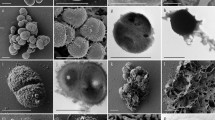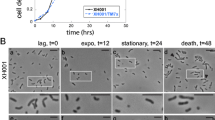Abstract
Stomatogenesis in ciliates is a complex and carefully orchestrated event. The exo− mutant SB255 ofTetrahymena thermophila has defects in mucocyst formation and docking and can also have one or two mouths. Three common culture media (proteose peptone, Medium 357, and yeast extract) were analyzed for total C, N, and inorganic elements and then tested for their effect on the number of mouths present in SB255. Cultures of SB255 grown in Medium 357 consisted of a mixed population of cells with either two mouths (doublet) or one mouth. Cultures from the same original stock grown in Medium 357 (SBm) and in 1% proteose peptone (SBpp) had different percentages of doublet cells in 1-, 2-, 3-, and 4-d-old cultures. When transferred to and grown in 1% yeast medium, both SBpp and SBm cultures had increased percentages of doublets over a 4-d culture period. When grown in 0.1, 0.5, or 1% yeast medium for 2 d, both SBpp and SBm cultures had more doublets in 1% than in either 0.1 or 0.5% yeast medium. Cultures of SBm grown in Medium 357. or 1% yeast medium for 2 d had a 10-fold increase in doublet cells compared to the inoculum. After 2 d in 1% proteose peptone, SBm cultures had percentages of doublet cells almost equal to that of the inoculum. Immunofluorescence and scanning electron microscopy (SEM) were used to examine cellular morphology of the doublet cells. These findings suggest that enriched media promote the growth of doublet cells. Furthermore, these doublets could prove to be a useful model system for the study of biological roles of trace elements.
Similar content being viewed by others
References
E. Orias, M. Flacks, and B. H. Satir,J. Cell Sci. 64, 49–67 (1983).
M. Jerka-Dziadosz and J. Frankel,J. Embryol. Exp. Morph. 49, 167–202 (1979).
J. Frankel and E. M. Nelson,Develop. Gen. 6, 213–238 (1986).
J. Frankel and E. M. Nelson Intracellular pattern reversal inTetrahymena thermophila. II. Transient expression of ajanus phenocopy in balanced doublets.Develop. Biol. 114, 72–86 (1986).
E. M. Nelson and J. Frankel,Develop. Biol. 114, 53–71 (1986).
M. P. Capdevila and A. Garcia-Bellido,Nature 250, 500–502 (1974).
D. M. Lilly, inChemical Zoology (Kidder, G. W., Ed.), Vol. 1, Academic, Press, New York, pp. 275–307 (1967).
D. L. Hill, inCell Biology: A Series of Monographs (Buetow, D. E., Padilla, G. M., and Cameron, I. L., Eds.), Academic, New York, pp. 176–192 (1972).
S. H. Hutner, H. Baker, O. Frank, and D. Cox, inBiology of Nutrition, R. N. T-W-Fiennes, ed., Pergammon, Oxford, pp. 85–177 (1972).
J. V. Slater,Physiol. Zool. 25, 283–287 (1952).
R. P. Hall,J. Protozool. 1, 74–79 (1954).
A. Tiedtke,J. Protozool. 32(2), 317–320 (1985).
N. V. Hue and C. V. Evans, inDepartmental Series No. 106, Department of Agronomy and Soils, Auburn University, AL (1986).
B. Estridge, A. Southwood, M. Mayo, and C. A. SundermannJ. Eukary. Microbiol. 40(1), 13A (1993).
E. M. Nelson,Develop. Biol. 66, 17–31 (1978).
W. J. Gehring,Science 236, 1245–1252 (1987).
N. Laskowski,Manufacuter's Typical Analysis, Difco Laboratories, Inc., Detroit (1992) (personal communication).
G. W. Kidder, V. C. Dewey, and R. E. Parks, Jr.,Physiol. Zool. 24, 69–75 (1951).
J. S. Roth,Exp. Cell Res. 10, 146 (1956).
M. Czupryn, K. H. Falchuk, and B. L. Vallee,Biochemistry 26, 8263–8269 (1987).
V. V. Agte, S. A. Chiplonkar, and M. K. Gokhale,Ann. NY Acad. Sci. 669, 313–316 (1992).
K. M. Downey and A. G. So, InMetal Ions in Biological Systems, H. Sigel, ed., Vol. 25, Marcel Dekker, New York, pp. 1–30 (1989).
M. J. Kendrick, M. T. May, M. J. Plishka, and K. D. Robinson, inMetals in Biological Systems, J. Burgess, ed.., Ellis Horwood, West Sussex, England, pp. 130–138 (1992).
Author information
Authors and Affiliations
Rights and permissions
About this article
Cite this article
Christopher, G.K., Sundermann, C.A. Doublet cells inTetrahymena as indicators of culture media composition. Biol Trace Elem Res 50, 181–191 (1995). https://doi.org/10.1007/BF02785409
Received:
Accepted:
Issue Date:
DOI: https://doi.org/10.1007/BF02785409




